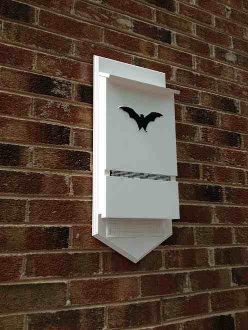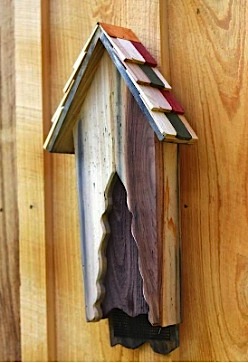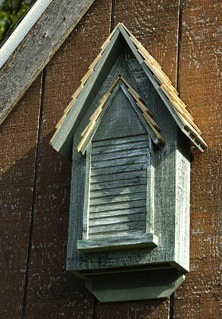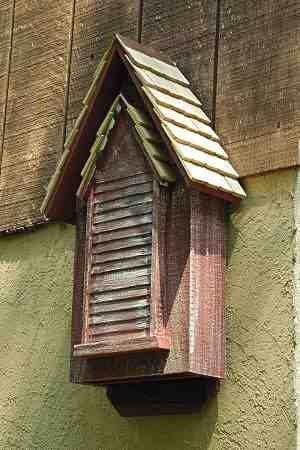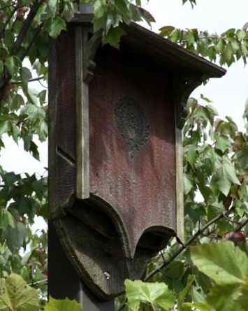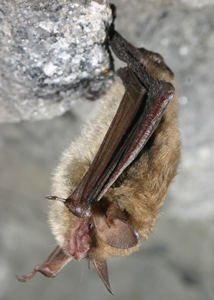-
Newest Bat Houses are Vinyl/PVC
Smart innovations (made in the USA) using durable materials means better quality, especially for items that remain outdoors. For seven years, we’ve had phenomenal feedback on all of our vinyl birdhouses and feeders – in fact some folks even thought they were made from wood!
With the popularity of natural insect control, and the increasing aversion to pesticides (thank goodness), bat houses have become a top preference for zapping those blood-sucking, nasty insects!
This brand new bat shelter with many a creature comfort will entice friendly brown bats and keep them roosting around your place. One tiny single bat can eat more than 1000 mosquitoes per night, now multiply that by 65, which is the approximate capacity here.
Made in the USA, the new vinyl design is completely impervious weather… will not crack, warp, split or mildew. The light color actually helps cool the box and stabilize inside temperatures during warm summer months. That’s important stuff if you’re a bat! It also blends well with the lighter colors of exterior paint on many homes – and that’s important stuff to people, it won’t stick out like a sore thumb!
Mounting height should be at least 15 ft. from the ground, on any structure, tree, or 4×4 post. Be sure entry is free and clear of any limbs or branches which might impede landing. It may take a little time for bats to discover their new digs, but if they already reside in your area, occupancy could be immediate. Having water nearby is more appealing to them; as in a creek, lake, stream or pond. Not a requirement, but more suitable habitat.
So vow to quit the bug zappers and chemicals this year, it’s far better for everyone’s health and the environment too. Try a bat house and entice these friendly, furry little mammals to your yard!
-
Attract Them and Offer Roosts with Bat Houses
They make some cool shelters these days, from vintage to Victorian, recycled plastic, even kits to build your own bat houses. You can try your luck at attracting bats without a big investment. But why would anyone want to attract them? One word – beneficial would sum it up best!
Bats are major pollinators and seed spreaders. Natural insect control is another huge advantage to hosting these friendly mammals (yes, they’re mammals). Even small bat colonies will consume thousands of mosquitoes and other pests nightly.
Habitat plays a key role in attracting any friendly fliers to your place. This holds true for butterflies, hummingbirds and songbirds too. If pesticides are being used, stop! They’re harmful to the to the environment, wildlife and the ecosystem in general. Pristine, manicured lawns are becoming passe, more naturalized areas are in style. This doesn’t mean jungle… it involves use of native plants, naturalized beds, and varied habitat.
You can attract bats by offering places for them to roost (other than your attic vents). Bat houses needn’t be plain square boxes, but stylish shelters that complement the landscape. The two shown are handcrafted in the USA, and made from solid cypress.
If water exists on your property, there’s a strong likelihood bats will use your shelters. Being near a creek, stream, or pond is preferable. They require a stable environment, steady temperatures within their roosts. Facing the houses south will allow full sun exposure to warm the boxes. Two bat houses are even better, facing them in different directions and allowing for varying temperatures. Leaving an outside light on at night may also assist in bringing bats to your place. As bugs swarm the light, bats will follow if they’re currently near your property.
Height is important when installing the houses as well. Some say 10 feet is sufficient, others claim 15-20 feet from the ground is best. Mount directly on a tree, structure or pole.
You can learn more about housing specs and hosting bats from The Organization for Bat Conservation.
-
These Guys Use Bat Houses too – Please Advocate for Them
Almost eight years later and we’re still dealing with the mysterious fungus known as white nose syndrome which is critically affecting the bat population. Originating in the northeastern US, it’s continually spreading further west and south. Although it may seem trivial to some, the furry, winged mammals (yes they’re mammals) play a key role in the eco-system… especially to farmers and their crops.
A little cl
oser to home, as in our own backyards, bats help control insect populations with behavior that for the most part, goes unnoticed. They just happen to be some of our major pollinators too!
By offering shelter in the form of bat houses, you’ll encourage the critters to stick around. Several species are known to use the houses for roosting, and the shelters range in size from a single chamber to larger 5-chamber models. There’s even designer bat houses to enhance your landscape!
If you can spare 60 seconds, please see the quick note below from the Center for Biological Diversity, and take a stand for bats… thanks!
Since 2006 a deadly fungal disease called white-nose syndrome has killed nearly 7 million North American bats, pushing several species to the brink of extinction and creeping farther across the country every year.
But at least one of these species may get big help from the feds: The U.S. Fish and Wildlife Service has proposed to protect northern long-eared bats under the Endangered Species Act.
These bats have declined by 98 percent over a large portion of their range, and have been waiting a painfully long time for an emergency rescue. But — just as life-saving protections are in sight — the Service’s proposal to protect the creatures could be derailed by greedy energy companies, who are lining up to limit the bat’s protection.
Please take action now to tell the Fish and Wildlife Service to protect northern long-eared bats without delay. If we wait any longer, it may well be too late.

